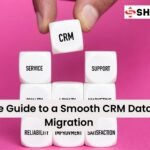CMastering the CRM Go-Live Process
When it comes to implementing a new CRM system, the go-live process can often be a challenging and crucial step. Ensuring a successful CRM go-live is essential for maximizing the benefits of your CRM investment. In this blog post, we will explore 10 easy steps to help you master the CRM go-live process and achieve success.
CRM is set to grow by 12% over the next five years, reaching a massive $129 billion by 2028.
1. Understand Your CRM Goals
Before diving into the CRM go-live process, it’s vital to pinpoint what you’re aiming to achieve. What’s your endgame with this new CRM system? Aligning its capabilities with your business’s overarching objectives is the first critical step. This isn’t just about having a shiny new tool; it’s about ensuring that this tool propels your business forward.
Ask yourself, what specific problems are you solving? Are you looking to improve customer relationships, streamline sales processes, or enhance internal communication? The clearer your objectives, the smoother the implementation will be. It’s not just about setting goals but making sure they are SMART: Specific, Measurable, Achievable, Relevant, and Time-bound.
Imagine, for a moment, a scenario where your goal is to increase sales by 20% within a year of implementing the CRM. This goal is not only clear but it also guides the customization of the CRM to ensure it’s equipped with the right tools to track and foster lead generation and sales conversion processes.
In another case, your aim might be to enhance customer satisfaction. Here, the CRM could be tailored to offer insights into customer behaviors, preferences, and feedback, enabling more personalized and timely interactions. Each goal requires a unique setup and focus, demonstrating why understanding your CRM goals is paramount.
There is no one size fits all
Remember, a CRM system is not a one-size-fits-all solution. It needs to be molded to fit your unique business processes and objectives. Engage with stakeholders across your organization to gather a holistic view of what everyone needs from the CRM. This collaborative approach not only ensures that the system meets various departmental requirements but also promotes a sense of ownership and acceptance among users.
In sum, knowing what you want to achieve sets the stage for everything that follows in the CRM go-live process. It informs your strategy, guides your customization efforts, and ensures that every step you take moves you closer to your business goals. Without this clarity, the path forward becomes much more challenging to navigate.
Table 1: CRM Goals and Objectives
| Objective | Details | SMART Criteria |
|---|---|---|
| Increase Sales by 20% | Customize CRM to track and enhance lead generation and conversion. | Specific, Measurable, Achievable, Relevant, Time-bound |
| Enhance Customer Satisfaction | Tailor CRM for personalized customer interactions and feedback. | Specific, Measurable, Achievable, Relevant, Time-bound |
| Improve Internal Communication | Integrate CRM with internal messaging and project management tools. | Specific, Measurable, Achievable, Relevant, Time-bound |
2. Assemble Your Dream Team
Putting together your dream team is a vital step in the CRM go-live journey. You need a group of passionate, skilled individuals from across your organization. This team should include representatives from sales, marketing, customer service, IT, and any other department that will use the CRM system. Why? Because getting input from various departments ensures that the system works well for everyone.
Choosing the right people is key. Look for individuals who are not only knowledgeable about their department’s needs but also open to change and skilled in problem-solving. These are the people who will identify potential issues before they become problems, suggest practical solutions, and help their colleagues adapt to the new system.
Most businesses get a standard ROI of $8.71 for every dollar spent on sales CRM software.
This dream team will lead the charge, acting as a bridge between the CRM technology and the rest of the organization. They’ll be responsible for making decisions on customization, managing data migration, and setting up processes that align with your business goals. Their insider knowledge of day-to-day operations makes them invaluable in tailoring the CRM to fit like a glove.
Communication is another critical role for your team.
They’ll need to keep everyone in the loop about the progress, address concerns, and gather feedback. This continuous dialogue helps in fine-tuning the system and making everyone feel involved and heard.
Remember, the success of your CRM go-live doesn’t just depend on the technology itself but also on the people implementing it. By assembling a team of committed, cross-functional experts, you’re laying a strong foundation for a smooth and successful CRM go-live. Their expertise, combined with a thorough understanding of your business needs, will ensure that the CRM system not only goes live successfully but also brings long-term benefits to your organization.
Table 2: Assembling the Dream Team
| Department | Role | Responsibilities |
|---|---|---|
| Sales | Sales Representative | Identify CRM needs, suggest features for sales process. |
| Marketing | Marketing Manager | Customize CRM for campaign tracking and lead management. |
| Customer Service | Customer Service Lead | Ensure CRM supports customer interaction and case management. |
| IT | IT Specialist | Manage technical setup, data migration, and integration. |
3. Cleanse Your Data
Before diving into the CRM go-live, ensuring your data is clean is a must. It’s like setting the stage for your CRM’s debut performance. Dirty data—full of duplicates, inaccuracies, and outdated information—can throw a wrench in the works. Here’s how to make your data sparkle.
Start by identifying and removing duplicates. These are the pesky twins and triplets in your data that confuse everyone. Use tools or features within your CRM system designed for this very task. They can spot duplicates you might miss.
Next, tackle outdated information. Have customers moved? Changed phone numbers? You’ll want your CRM to reflect the current reality. Reach out, update records, or use data verification services. It’s a bit like detective work, but the rewards—a database you can trust—are worth it.
Accuracy is Key
Accuracy is your next target. Incorrect data can lead to misinformed decisions and frustrated customers. Verify the details. It might mean checking email addresses are still active or ensuring contact names are spelled right. Attention to detail here prevents headaches later.
Don’t forget to standardize your data. This means making sure everything follows a consistent format. Phone numbers, addresses, and dates should all look the same. This not only looks neater but also helps with data analysis down the line.
65% of companies start using a CRM within their first five years in business.
Finally, enrich your data. This is about adding valuable information that wasn’t there before. Maybe it’s segmenting customers by industry or adding social media profiles. This extra layer makes your CRM more powerful, offering deeper insights and personalization opportunities.
Cleaning your data isn’t a one-time event. It’s an ongoing process that requires regular check-ups. But start strong, and you’ll pave the way for a CRM that truly performs, making all the effort worth it. Remember, clean data is the foundation of your CRM’s success. Without it, even the best systems struggle to deliver the insights and efficiencies you’re aiming for.
Guide: Data Cleansing Steps
- Identify Duplicates: Use CRM tools to locate and merge duplicate records.
- Update Outdated Information: Verify and update contact details through outreach or data verification services.
- Ensure Accuracy: Check and correct incorrect data entries manually or with data validation tools.
- Standardize Data: Ensure consistency in formats for phone numbers, addresses, and dates.
- Enrich Data: Add additional valuable information such as customer segmentation and social media profiles.
4. Tailor the CRM to Fit
Customizing your CRM is like tailoring a suit; it should fit your company’s needs perfectly. Every organization operates uniquely, with its own processes and challenges. That’s why a one-size-fits-all approach to CRM implementation doesn’t work. Customizing your CRM ensures it aligns with your specific business workflows, thereby enhancing efficiency and user adoption.
Start by mapping out your existing workflows. Understand how information flows within your organization and identify any bottlenecks or inefficiencies. This step is crucial because it informs how the CRM should be structured to support or improve these processes.
Next, consider the user interface (UI). The easier and more intuitive the UI, the quicker your team will adopt the new system. Customize dashboards and menus to ensure that users have easy access to the tools and information they use most often. This can significantly reduce the learning curve and increase productivity.
Don’t forget to integrate with other tools. Your CRM doesn’t operate in a vacuum. It should seamlessly integrate with email platforms, social media, accounting software, and any other tools your team relies on. This integration ensures that data flows freely between systems, reducing manual entry and the potential for errors.
Testing is also a part of the customization process.
As you tailor the CRM to fit your needs, regularly test these customizations to ensure they work as intended. Gather feedback from your team during these tests to make further adjustments. This iterative process helps in refining the system until it perfectly matches your business requirements.
Remember, customization is not a one-time task. As your business evolves, your CRM should evolve with you. Regularly review and adjust your customizations to ensure the CRM continues to meet your changing needs. This ongoing customization process keeps your system efficient and relevant, supporting your business’s growth and success.
Template: CRM Customization Plan
| Task | Details | Assigned To | Deadline |
|---|---|---|---|
| Map Existing Workflows | Document current workflows and identify gaps. | Process Analyst | MM/DD/YYYY |
| Customize User Interface (UI) | Design intuitive dashboards and menus. | UI/UX Designer | MM/DD/YYYY |
| Integrate with Other Tools | Connect CRM with email, social media, etc. | IT Specialist | MM/DD/YYYY |
| Conduct User Testing | Gather feedback and refine customizations. | Project Manager | MM/DD/YYYY |
5. Test Everything
Before the big day arrives, putting your CRM through its paces is crucial. Think of this step as a dress rehearsal before the actual performance. Start with testing the data migration. It’s essential to ensure all data makes its smooth transition without hiccups. Are contacts where they should be? Are sales histories intact? This phase catches any migration issues before they become major headaches.
Next up, user interfaces (UIs) need a thorough examination. Can your team navigate the new system with ease? Is finding information straightforward? This is about making sure the CRM doesn’t just work, but works well for those who will use it daily.
74% of companies say CRM technology gives better access to customer data.
Don’t overlook testing integrations. Your CRM needs to chat seamlessly with other software your business uses. Whether it’s email platforms, social media, or accounting software, ensure these conversations between systems are glitch-free. Smooth integration is key to avoiding data silos and ensuring a cohesive workflow.
Performance testing is also vital. How does the system hold up under heavy use? Simulate the real-world demands it will face. This step is about ensuring the CRM remains stable and responsive, even under stress.
Involve end-users in the testing process. Their feedback is invaluable, as they’re the ones in the trenches. They might spot issues or improvements that weren’t initially obvious. Plus, involving them early on aids in smoother adoption when you go live.
Testing isn’t just a tick-box exercise
It’s about proactive problem-solving. Identify and fix issues now to save time and frustration later. Remember, the goal is a CRM that not only goes live smoothly but also supports your business effectively from day one.
Table 3: CRM Testing Checklist
| Test Area | Details | Status |
|---|---|---|
| Data Migration | Verify all data is accurately transferred. | Complete/In Progress/Not Started |
| User Interface (UI) | Ensure usability and accessibility. | Complete/In Progress/Not Started |
| Integration Testing | Test connections with other software tools. | Complete/In Progress/Not Started |
| Performance Testing | Assess system performance under load. | Complete/In Progress/Not Started |
| User Feedback | Collect and implement user feedback. | Complete/In Progress/Not Started |
6. Train Your Users
Training your users isn’t just about showing them how the new CRM system works; it’s about ensuring they feel confident and competent from day one. Effective training transforms your team from mere users to CRM champions. Here’s how to make it happen.
Start by identifying different learning styles within your team. Some may prefer hands-on training, while others might find video tutorials or written guides more helpful. Offering a mix of training methods ensures no one is left behind.
Create a comprehensive training schedule that covers all the necessary skills and knowledge. Break down the training into digestible modules, focusing on the essential functions first. This modular approach prevents information overload and helps users retain what they’ve learned.
Make sure to include practical exercises that mimic real-life scenarios. This practice allows users to apply what they’ve learned in a controlled environment, building their confidence. It’s one thing to learn about a feature and another to use it to solve a problem or complete a task.
Incorporate a ‘train-the-trainer’ model where you equip key team members with the knowledge and tools to train others. These internal trainers can provide personalized support, answer questions, and offer tips and tricks they’ve discovered. This peer-to-peer learning can be incredibly effective and fosters a supportive team environment.
Users Need Support
Provide ongoing support and resources after the initial training. Set up a help desk, Q&A sessions, or an online resource hub where users can find answers to their questions or refresh their knowledge as needed. This ongoing support is crucial as users start to use the CRM in their everyday work and encounter new situations.
Remember, training for CRM go-live is not a one-off event. It’s an ongoing process that adapts as your team grows and your business evolves. By investing in comprehensive and continuous training, you’re not just preparing your team for the go-live; you’re setting them up for long-term success with the CRM system.
Guide: Training Your Users
- Identify Learning Styles: Determine preferences for hands-on, video, or written guides.
- Create Training Schedule: Develop a modular schedule focusing on essential functions first.
- Include Practical Exercises: Simulate real-life scenarios for hands-on practice.
- Train-the-Trainer Model: Equip key team members to train others.
- Ongoing Support: Provide continuous help through a helpdesk, Q&A sessions, or resource hub.
7. Plan Your Go-Live in Phases
Diving headfirst into a full-scale CRM go-live might seem tempting, but it’s akin to trying to sprint before warming up. Instead, break it down into digestible, manageable phases. This phased approach reduces stress on your team and minimizes the risk of major disruptions to your day-to-day operations.
First, identify key milestones in your CRM go-live journey. These could range from initial data migration to full user adoption. By setting these milestones, you create a roadmap that’s easy to follow and adjust as needed.
Next, start with a pilot phase. Select a small, controlled group of users to use the CRM system before a full rollout. This group can provide critical feedback and help identify any tweaks or fixes needed, ensuring a smoother transition for the wider team later on.
Then, proceed to departmental rollouts. Instead of going company-wide, introduce the CRM system to one department at a time. This allows for focused training and support, making it easier to address specific departmental needs and challenges.
Throughout each phase, monitor performance closely. Keep an eye on how the system is handling real-world tasks and whether it’s meeting the expectations set out in your initial goals. This ongoing evaluation is crucial for catching any issues early and making necessary adjustments.
Finally, communication is key.
Keep everyone informed about what phase the go-live process is in, what’s expected of them, and any changes that might affect their work. Transparent communication helps manage expectations and fosters a supportive environment for feedback and questions.
By planning your CRM go-live in phased, structured steps, you’re not just aiming for a successful launch. You’re building the foundation for a CRM system that’s well-integrated into your business processes, supported by your team, and poised for long-term success.
Table 4: Phased Go-Live Plan
| Phase | Tasks | Duration |
|---|---|---|
| Pilot Phase | Test CRM with a small group, gather feedback. | 2 Weeks |
| Departmental Rollout | Implement CRM in one department at a time, provide support. | 1 Month/Dept |
| Full Implementation | Roll out CRM across all departments. | 2 Months |
8. Support Your Team
During the CRM go-live, your team needs more than just instructions; they require real support. This means being there to answer questions, solve problems, and offer guidance as they navigate the new system. It’s crucial to create an environment where they feel comfortable seeking help.
Set up dedicated support channels. This could be a helpdesk, an internal chat group, or scheduled check-in meetings. The goal is to make it easy for team members to reach out without feeling like they’re burdening someone. These channels should be staffed by knowledgeable individuals who can provide quick, effective solutions.
Offer personalized assistance. Not everyone will adapt at the same pace, and some might need extra help. Offer one-on-one sessions for those who need it. This attention can make a significant difference in how quickly and effectively someone learns to use the CRM.
Encourage peer support. Often, team members can learn a lot from each other. Foster a collaborative atmosphere where they can share tips, tricks, and solutions. This not only helps with problem-solving but also strengthens team bonds.
Listen actively. When someone comes to you with a concern or issue, listen to understand, not just to respond. Sometimes, the act of listening can reveal underlying problems that need addressing. It also shows your team that their input is valued and taken seriously.
Remember, support during the CRM go-live is not just about solving technical issues.
It’s also about helping your team adjust to a new way of working. By providing the right mix of technical help, personal assistance, and active listening, you help pave the way for a smoother transition and a more successful CRM adoption. This approach demonstrates your commitment to not just the system’s success, but to your team’s well-being and confidence in using the CRM.
Guide: Supporting Your Team During Go-Live
- Set Up Support Channels: Create helpdesk, chat groups, or check-in meetings.
- Offer Personalized Assistance: Provide one-on-one sessions for those needing extra help.
- Encourage Peer Support: Foster a collaborative environment for sharing tips and solutions.
- Listen Actively: Address concerns and demonstrate that feedback is valued.
9. Gather Feedback Early and Often
Starting from day one, make collecting feedback from your team a top priority. Their insights are invaluable for refining the CRM system. Don’t wait until everything seems settled. Early feedback identifies quick wins and areas needing immediate attention, making adjustments while the experience is fresh in users’ minds.
Create a structured, yet simple, way for team members to share their thoughts. Whether it’s through an online survey, a dedicated email address, or regular feedback sessions, ensure the process is easy and accessible. This openness encourages more honest and detailed feedback.
Ask specific questions to guide feedback. Instead of general inquiries like “How do you like the CRM?”, ask “What features do you find most useful?” or “What challenges are you facing with data entry?”. This specificity helps in gathering actionable insights that can directly influence improvements.
It’s also crucial to respond to the feedback. Let your team know their input doesn’t disappear into a void. When possible, implement changes based on their suggestions and communicate back what actions were taken. This not only improves the CRM system but also builds trust and a sense of ownership among users.
Continuous Feedback is needed
Encourage a culture of continuous feedback, not limited to the go-live phase. As your team grows more accustomed to the CRM, their needs and usage patterns may change. Staying attuned to their evolving feedback ensures the CRM remains a robust tool that truly supports your business objectives.
By gathering feedback early and often, you’re not just troubleshooting; you’re engaging your team in a continuous improvement process. This collaborative approach ensures your CRM system doesn’t just meet expectations at launch but evolves to become an integral part of your business success.
Template: Feedback Collection
| Feedback Area | Questions to Ask | Method |
|---|---|---|
| User Interface (UI) | “What features do you find most useful?” | Online Survey |
| Data Entry | “What challenges are you facing with data entry?” | Feedback Sessions |
| Overall Experience | “How can the CRM be improved to better support you?” | Regular Meetings |
Guide: Post-Go-Live Iteration
- Celebrate Success: Recognize team efforts and milestones achieved.
- Regular Check-Ins: Discuss CRM performance and areas for improvement.
- Encourage Continuous Feedback: Keep gathering user insights for ongoing refinement.
- Experiment with New Features: Stay open to new functionalities and integrations.
- Review and Adjust Regularly: Ensure the CRM adapts to evolving business needs.
10. Celebrate and Iterate
After your CRM goes live, take a moment to celebrate this significant milestone with your team. Their effort and commitment have been crucial to this journey, and it’s important to recognize their contributions. A successful CRM launch is a big win, but remember, it’s not the end of the road.
Seeing the go-live as a starting line rather than a finish line is key. Your CRM system will evolve, and so will your team’s needs and the way they use the system. Keep the momentum of improvement rolling by continuously seeking ways to enhance and refine your CRM based on real-world use and feedback.
Set up regular check-ins to discuss how the CRM is performing. Are there features that could be tweaked for better efficiency? Is the system meeting the users’ expectations? These meetings can be invaluable for spotting opportunities to make your CRM even more powerful.
Also, encourage your team to keep sharing their insights and suggestions. Their day-to-day experiences with the CRM are a goldmine of information that can help make the system even more beneficial for everyone. Make sure they know that their input is not only welcomed but essential for ongoing success.
Don’t shy away from experimenting with new features or integrations that could enhance your CRM’s capabilities. Technology evolves rapidly, and staying open to new possibilities can give your business a competitive edge.
Finally…
In short, celebrate your CRM go-live, but also embrace the mindset of continuous improvement. By doing so, you ensure that your CRM system remains a dynamic, valuable tool that grows alongside your business. This ongoing journey of iteration and enhancement will help keep your team engaged and your business thriving.
Share this information and please subscribe to our newsletter and website.














